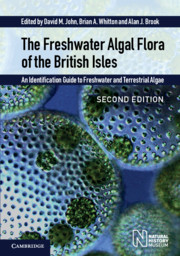 The Freshwater Algal Flora of the British Isles
The Freshwater Algal Flora of the British Isles Published online by Cambridge University Press: 12 January 2024
The Water Framework Directive (2000/60/EC) is the most significant piece of European water legislation for the protection, improvement and sustainable use of surface waters, transitional waters, coastal waters and groundwater across Europe (European Union, 2000). A key component of the Water Framework Directive (WFD) is the development of classification tools for determining the ecological status of surface waters, with the ecological status being divided into one of five classes (High, Good, Moderate, Poor or Bad). The aim is to ensure that all water bodies attain Good ecological status by 2015 (UKTAG, 2007). The class given to a particular water body represents an estimate of the degree to which the structure and functioning of the aquatic ecosystem supported by the water body have been altered by all the different pressures to which that water body is subject. This means that the results of classification will reflect the impacts of a much wider range of pressures on the water environment than do previous classification schemes.
The classification tools use a range of biological quality elements (BQEs), supported by measurements of physical and chemical determinands, hydrology and morphology. The algal community iswidely considered the first biological community to respond to eutrophication pressures and is the most direct indicator of all the BQEs of nutrient concentrations in the water (Carvalho et al., 2007). Excessive growths of phytoplankton are exacerbated by eutrophication, reducing the amenity and conservation value of affected sites. Moreover, cyanobacteria are arguably the most visible symptoms of eutrophication, with increasing frequencies and intensities of toxic cyanobacteria blooms resulting in numerous socio-economic problems. The algal tools are based on changes in the species composition and abundance of the algal flora in response to nutrient pressure. In the UK, separate ecological classification tools have been developed for phytobenthos (benthic diatoms) for standing waters (lochs/lakes) and rivers, although they share a common approach, and there is also a tool for phytoplankton in standingwaters (UKTAG, 2007). No ecological assessment is carried out in the UK using phytoplankton in rivers.
Sample collection for the Water Framework Directive
Sample collection methods are well standardized within the European Union. Benthic diatoms are collected during spring and autumn periods by brushing or scraping the upper surfaces of cobbles or small boulders from the river bed or from the littoral zones of lakes/lochs, in order to remove the biofilm.
To save this book to your Kindle, first ensure [email protected] is added to your Approved Personal Document E-mail List under your Personal Document Settings on the Manage Your Content and Devices page of your Amazon account. Then enter the ‘name’ part of your Kindle email address below. Find out more about saving to your Kindle.
Note you can select to save to either the @free.kindle.com or @kindle.com variations. ‘@free.kindle.com’ emails are free but can only be saved to your device when it is connected to wi-fi. ‘@kindle.com’ emails can be delivered even when you are not connected to wi-fi, but note that service fees apply.
Find out more about the Kindle Personal Document Service.
To save content items to your account, please confirm that you agree to abide by our usage policies. If this is the first time you use this feature, you will be asked to authorise Cambridge Core to connect with your account. Find out more about saving content to Dropbox.
To save content items to your account, please confirm that you agree to abide by our usage policies. If this is the first time you use this feature, you will be asked to authorise Cambridge Core to connect with your account. Find out more about saving content to Google Drive.